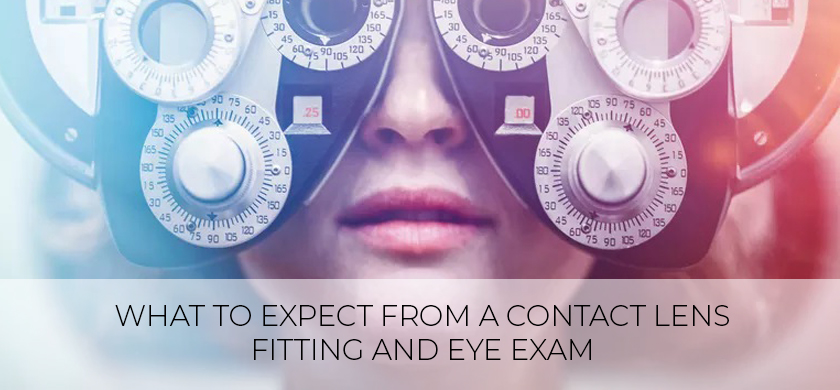
Whether you are having vision problems or not, you must get your eyes checked annually to ensure optimal vision. Make sure to add it on your to-do-list. But keep in mind that a routine eye exam is not the same as a contact lens exam. The technology of contact lenses has rapidly evolved over the years. Now there are contact lenses for everyone. Be it for vision correction, for beautifying your looks or just for sports or special occasions. This is the added bonus of contacts, the flexibility it gives the individual patient according to their lifestyle. With a wide range of Korean circle lenses available in the market, with added specification according to your eye conditions, there is no reason not to join the bandwagon. If you are switching from eyeglasses to contacts, it’s extremely important that they are a perfect fit for you and ensure comfort.
The contact lens examination is not the same as a regular eye exam. It determines your overall eye health, if you are developing any eye condition or you need any assistance in vision correction. Your optometrist will also look for any inflammation or early signs of cataracts that cause night blindness. Retinal imaging is another vital part of the eye exam that can spot any potential cancer, glaucoma, degenerative condition and more. If you need vision correction, your doctor will give a prescription for eyeglasses. However, this prescription is not sufficient alone. Next step is to see whether you’re a good candidate for wearing contacts. The doctor will see if you have dry-eye syndrome, by evaluating your tear film, to make sure you produce enough tears for a comfortable lens wear. He will also ensure there is no other problem like astigmatism or presbyopia. After giving a go-head that you are suitable for contacts, the next step is to discuss your lifestyle and preferences, in order to get the best possible fit for you. Gone are the days when one type of lens fit all. With constant advancements and heavy investment in research and development of contact lens, there is a perfect one for you. Now they come in a huge array of materials, sizes, colors and wearing times. You can choose from daily disposable ones, to weekly to biweekly or even monthly wear contacts. Select the ones that suit your way of living. If you wear contacts every day, or travel a lot and don’t want the hassle of carrying multiple pairs then go for monthly wear ones, if you are an occasional wearer then opt for daily disposable ones which is recommended by doctors as it gives you a fresh clean start every day. You can also wear contacts to enhance your beauty by changing the color of your eyes. The main objective of this exercise is to find the brand and material that works best for your needs.
After finalizing these details it’s now time for the measurement of the eye. Contacts may all seem the same but there’re minute differences that change from eye to eye. Your doctor will take detailed measurements to ensure a comfortable wear. If the contacts are not a perfect fit it may cause discomfort, blurry vision and even cause damage to the eyes. The first one is the measurement of the corneal curvature, which ensures that the lens perfectly fits the curve of the eye. It is measured with an instrument called a keratometer to determine the proper curve for your contact lenses. For precise detailing the optometrist may use corneal topography. It provides great detail about the entire cornea, which is vital as the contact lens rests on your cornea and if it’s not fit as a gulf then it will be a hindrance in the optimal health of your eyes. If the doctor needs even more detailed information he might go for wavefront measurements. This test will reveal if you have astigmatism. It is an irregularity in the curvature of the cornea. With this condition, he might recommend a gas permeable or toric lens. After determining the curve of the eye it’s now time to measure the pupil and iris. This is the colored part of your eye, measured with an instrument called biomicroscope or slit lamp or manually with a ruler or card. This step is important to ensure that the contact lens not only fits properly but also blends in with the eye to give a natural look. After this the doctor will proceed toward the final step of the exam which is equally important as other steps mentioned above. One of the most common reasons a person might not be able to wear contacts is dry eyes. If there isn’t enough moisture to hydrate your eyes adequately the contacts will cause itchiness, redness and irritation. If not checked properly, the dryness can damage the surface of your eye, which can turn into infection. This process is done by putting a special liquid dye on your eye, then observing the tear flow with a slit lamp or by putting a strip under your eye to see how much moisture it has absorbed. A weak tear film means you might need a special kind of lens that ensures a regular flow of moisture.
After going from all this process, you will try on a pair of lenses to confirm the fit. He will make you wear it for about 15 mins and then examine the movement, tearing in your eyes. If everything goes smoothly, you can ask your doctor to order for you or there are many good online stores that offer discount contact lenses that will save your hard earned money. With all this done, now is the time for some guidance from the doctor, on how to properly disinfect your lens, good hygiene and insertion and removal of lenses, and how long you can wear it and the importance of the renewal of the pair after the expiry.
Now that you know what to expect from the contact lens fitting, gear up for your visit and list down any questions you may have.





